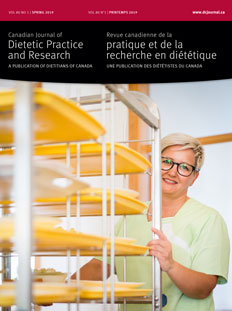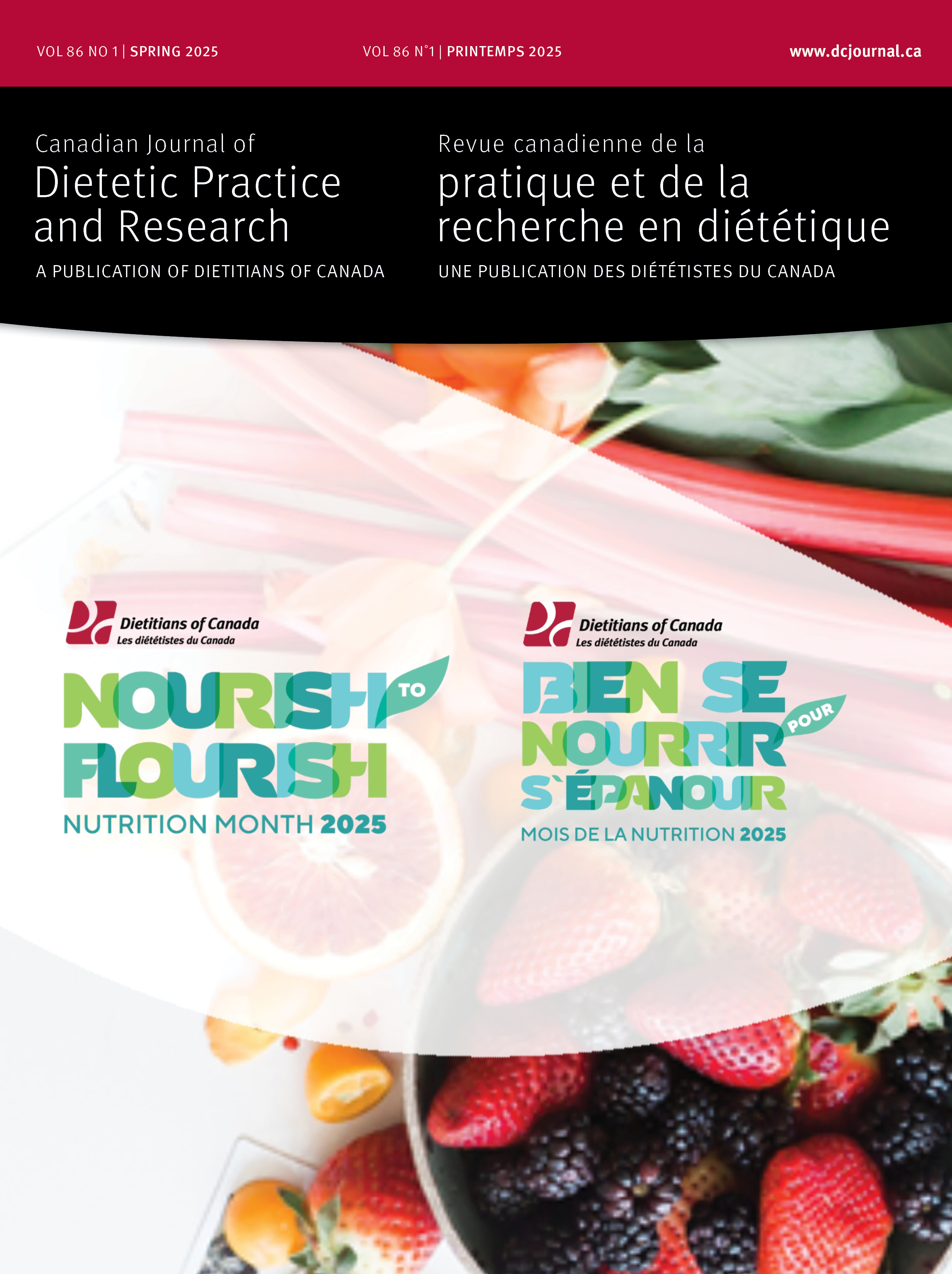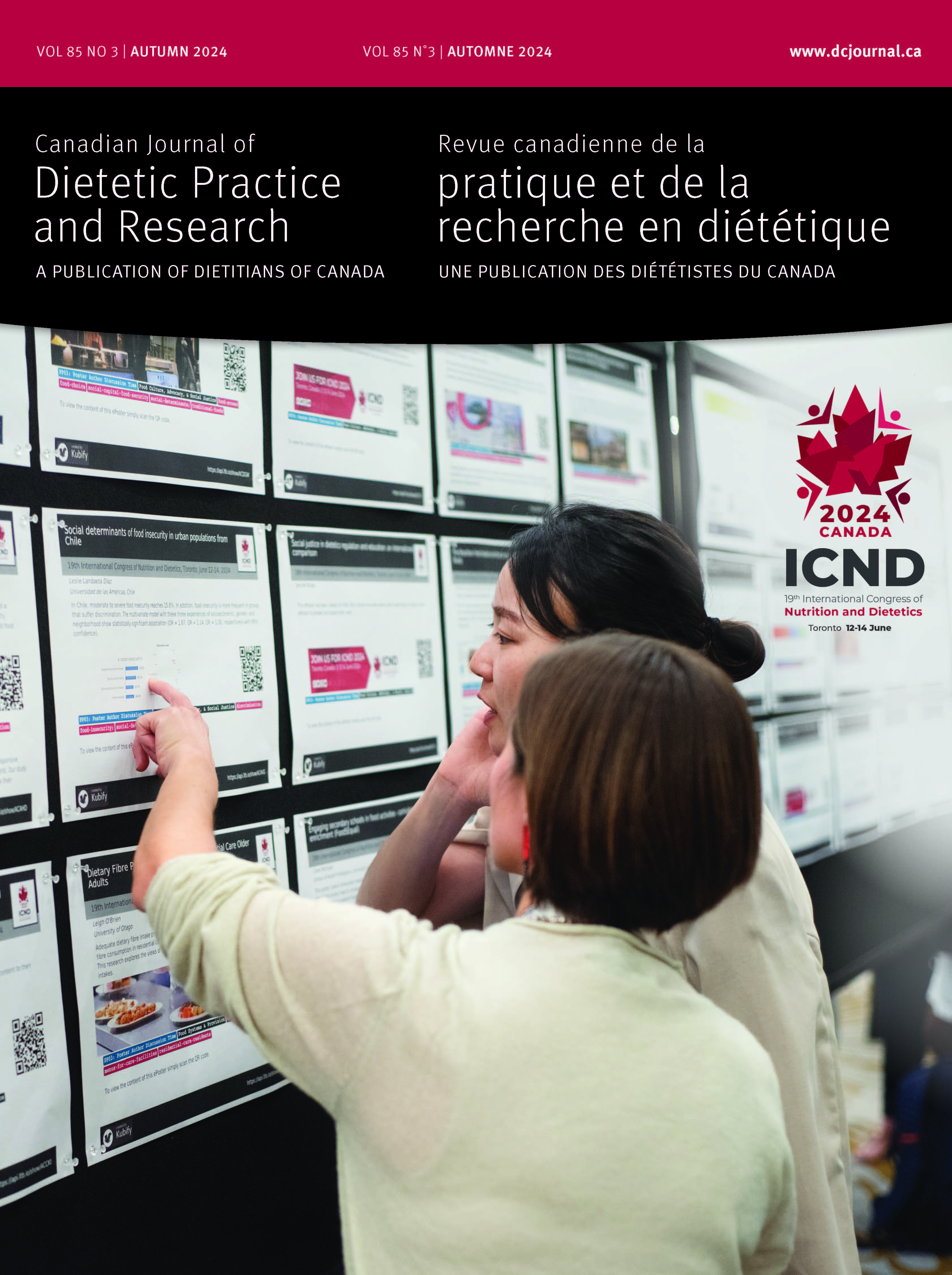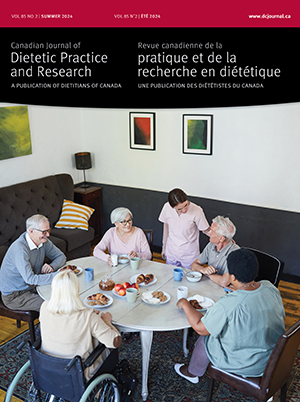Volume 80 • Number 1 • March 2019
Editor’s Message
Research
Purpose: To explore the extent to which knowledge- and skill-based learning regarding social justice and/or social justice advocacy is included in the course descriptions of required courses of accredited, English-speaking dietitian training programs in Canada.Methods: This study is a mixed-methods content analysis of required course descriptions sampled from university academic calendars for accredited, English-speaking dietitian training programs across Canada.Results: Quantitative analysis showed that required course descriptions (n = 403) included few instances of social justice-related terminology (n = 63). Two themes emerged from the qualitative analysis: competing conceptualizations of social issues and dietitians’ roles; prioritization of science-based knowledge and ways of knowing.Conclusions: Accredited, English-speaking dietitian training programs in Canada appear to include little knowledge- or skill-based learning regarding social justice issues and advocacy. Supporting future dietitians to pursue leadership roles in redressing social injustices and socially just dietetic practice may require more explicit education and training about social justice issues and advocacy skills.
Purpose: The purpose of this study was to determine the opinions and reported nutrition practices of Canadian Registered Dietitians (RDs) with regard to feeding patients with severe sepsis.Methods: In 2017, surveys were sent to 112 eligible Canadian RDs in 10 provinces who were practicing in an intensive care environment. The survey included embedded branching logic questions developed to address major facets of sepsis, critical illness, and nutrition. The survey instrument assimilated all data in an anonymous manner, so respondents could not be linked to their answers.Results: Of the 64 RDs who responded (57% response rate), the majority practiced in adult intensive care (81%), within an academic center (59%), and in a mixed unit (73%). A wide variability of Canadian RDs’ opinions and practice was reported in determining energy requirements, enteral nutrition (EN) practice, EN with vasoactive agents, parenteral nutrition (PN), and supplemental micronutrients.Conclusions: Practice variability of Canadian RDs likely reflects gaps in both evidence and guidelines for severe sepsis. Further research efforts are needed to customize nutritional requirements in the patient with evolving sepsis, EN with patients at high risk for gastrointestinal dysfunction, optimizing PN, and the role of micronutrients.
Purpose: Our study compared the prevalence of food insecurity among 3 student groups attending Memorial University of Newfoundland (MUN): International (INT), Canadian out-of-province (OOP), and Newfoundland and Labrador (NL). Factors associated with food insecurity were also investigated.Methods: Data were collected via an online survey distributed to an estimated 10 400 returning MUN students registered at a campus in St. John’s, NL. Respondents were recruited through e-mails, posters, and social media. Ten questions from the Canadian Household Food Security Survey Module adult scale were asked to assess food security. Logistic regression was used to compare rates of food insecurity between the three population subgroups.Results: Of the 971 eligible student respondents, 39.9% were food insecure (moderate or severe). After controlling for program type, parental status, living arrangement, and primary income source, OOP and INT students were 1.63 (95% CI = 1.11–2.40) and 3.04 (95% CI = 1.89–4.88) times more likely, respectively, to be food insecure than NL students.Conclusions: Approximately 40% of participating MUN students experienced food insecurity, a higher proportion than reported for the overall provincial population. Groups at high risk of food insecurity include INT students, students with children, and those relying on government funding as their primary income.
Purpose: Internationally, there is debate on whether a nutrient or a food-based approach to policy is more effective. This study describes the food/beverage availability in schools in Nova Scotia through a comparison of a traditional nutrient classification (“Maximum/Moderate/Minimum”), currently used in the provincial school policy and a simplified food-based system (“Core/Extra”).Methods: School food environment audits were conducted in schools (n = 25) to record the food and beverages available. Registered dietitians categorized information using both the nutrient-based and simplified food-based classification systems. Number and percent in each category were described for items.Results: Food and beverage items consisted of breakfast, lunch, snacks, beverages, and vending of which 81% were permissible by the policy, whereas only 54% were categorized as Core. Many snacks and vending items classified as Extra fell within either Moderate (45% and 35%, respectively) or Minimum (29% and 33%, respectively) categories.Conclusions: Dietitians have a role to support interpretation of classification systems for school nutrition policies. The nutrient-based classification used in the policy permitted some items not essential to a healthy diet as defined by the Extra food-based classification. However, the food-based Core/Extra categorization had less detail to classify nutrients.
Perspectives in Practice
Early detection of malnutrition in hospitalized patients is of paramount importance. As poor food intake is a marker of malnutrition risk, a simple and accurate method to monitor intake is valuable. This quality assurance project aimed to determine if food service workers (FSW) were able to provide accurate estimates of patient intakes through visually assessing meal trays at an acute care hospital. FSW conducted visual estimates of patient trays after meals using the meal plate pictorial rating scale adapted from the My Meal Intake Tool and translated their estimates into one of 5 consumption levels (0%, 25%, 50%, 75%, or 100%). A total of 401 patient meal estimates were validated using the food weighing method. Spearman’s correlations between percent calories consumed (determined by weight) and estimates by FSW were 0.624 (n = 137, P < 0.001), 0.771 (n = 134, P < 0.001), and 0.829 (n = 130, P < 0.001), for breakfast, lunch, and supper, respectively. Paired Wilcoxon tests and the Kruskal–Wallis H test showed that accuracy varied for breakfast, lunch, and supper. The overall sensitivity and specificity of FSW for detecting patient intake ≤50% was 81% and 88%, respectively. These findings identify that FSW can accurately estimate patient intake, contributing an important marker for the detection of malnutrition.
Adults with acute leukemia (AL) are at high risk of malnutrition due to their disease and treatment side effects and may be admitted to the intensive care unit (ICU), further increasing the risk of malnutrition. Although ICU care includes some form of nutrition, patients typically receive less than prescribed energy and protein. Our objective was to characterize the nutrition care for critically ill patients with AL. We completed a retrospective review of adults with AL admitted to the Medical/Surgical ICU >24 hours. Descriptive statistics were performed on collected data including: demographics, APACHE II and Nutric scores, nutrition therapy, reasons for withholding nutrition, and mortality status at discharge. Data were collected on 154 AL patients with an average APACHE II score of 27 and Nutric score of 5.96. ICU mortality was 36%. Enteral nutrition (EN) was most commonly prescribed. Patients on EN received 55% of energy and 51% of protein prescribed. EN was commonly withheld for airway management and gastrointestinal impairment. Patients with AL received low amounts of energy and protein in the ICU and had a high Nutric score. Strategies and barriers to improve protein intake in this population are identified.
Report
Purpose: To explore dietary changes Albertan women make during pregnancy, reasons they make changes, and alignment with prenatal nutrition recommendations.Methods: Women up to 6 months postpartum were recruited in public health centres and Primary Care Networks. Qualitative data were collected through a self-administered survey including 2 open-ended questions that asked about changes made to food/beverage intake during pregnancy and why these changes were made.Results: A majority (n = 577) of the 737 women completing the survey described changes they made to their food/beverage intake during pregnancy and 193 respondents provided reasons for these changes. Increased intake of fruits/vegetables, meat, milk, and their alternatives (n = 600); limiting or avoidance of foods/beverages known to be harmful during pregnancy (n = 445); and increased food/fluid intake or meal/snack frequency (n = 405) were commonly reported dietary changes. Motivations relating to health and to control physiological changes/manage health conditions were the most frequent reasons provided.Conclusions: Women make diverse dietary changes and have various motivations for food choices during pregnancy. A majority make dietary changes to support a healthy pregnancy. However, the motivation to control discomforts and respond to hunger and thirst sensations reflect a stronger influencer on women’s choices than is currently addressed in prenatal nutrition messages.
Purpose: The objectives of this study were (i) to describe ethnicity, tuition funding sources, and living arrangements during degree among Registered Dietitian (RD) and non-RD alumni of the University of Manitoba’s undergraduate nutrition program and (ii) to describe barriers to obtaining an internship among those who did not become an RD.Methods: A 31-item, self-administered, online questionnaire was distributed to nutrition graduates. Binary logistic regression was used to test for predictors of RD status (vs. non-RD).Results: Of the 195 participants who completed the survey (37% response rate), 68% identified as an RD and 31% did not. White students had 3.8 times higher odds of being an RD (P < 0.001) compared with students of an ethnic minority. Those who had received a student loan (P = 0.033) or lived with their parents during their degree (P = 0.004) also had significantly lower odds of being an RD. The most common barrier for not completing the dietetic internship by non-RDs was that the application process was too stressful.Conclusions: Results from this study highlight the need for the dietetics field to address systemic barriers for students of ethnic minorities and low socioeconomic backgrounds, including barriers during the degree program and in the internship selection process.










